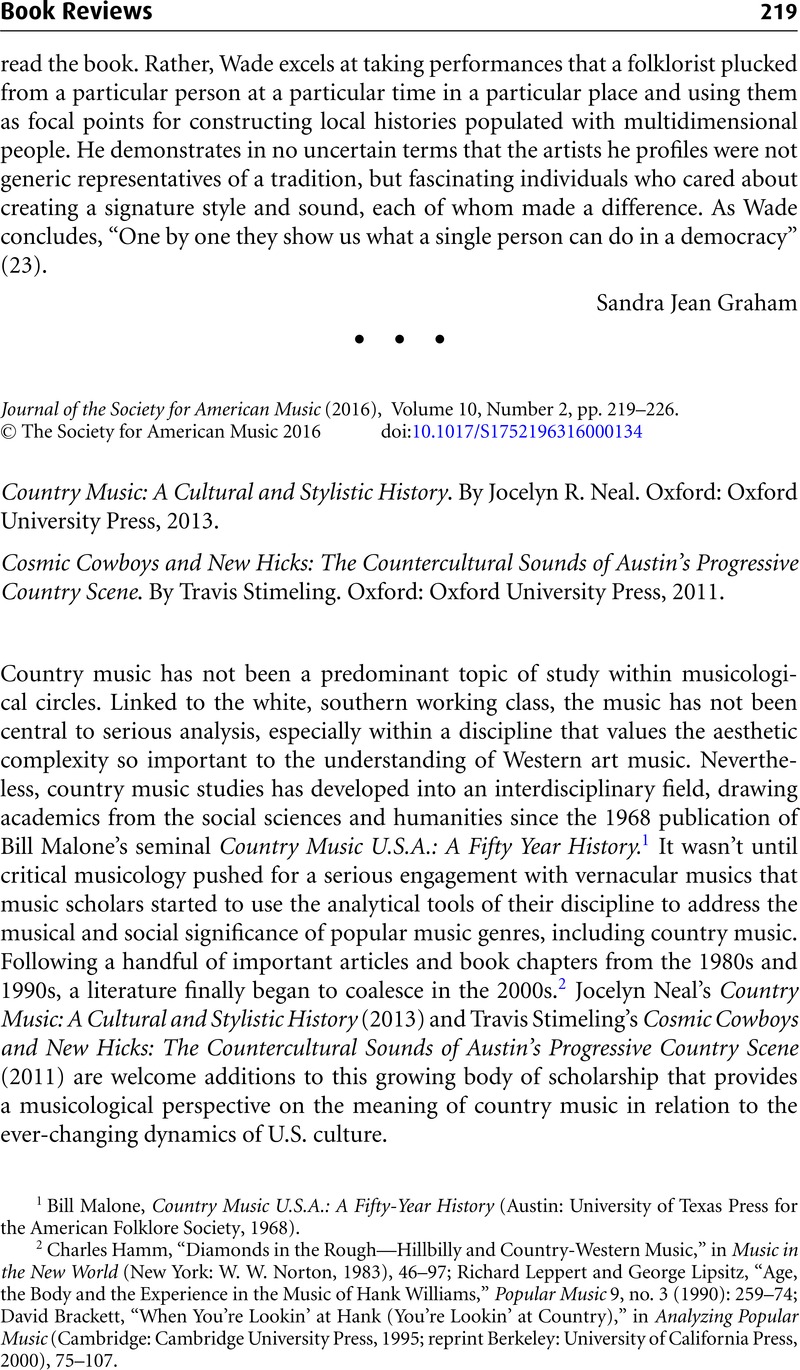No CrossRef data available.
Article contents
Country Music: A Cultural and Stylistic History. By Jocelyn R. Neal. Oxford: Oxford University Press, 2013. - Cosmic Cowboys and New Hicks: The Countercultural Sounds of Austin's Progressive Country Scene. By Travis Stimeling. Oxford: Oxford University Press, 2011.
Published online by Cambridge University Press: 18 May 2016
Abstract

- Type
- Book Review
- Information
- Copyright
- Copyright © The Society for American Music 2016
References
1 Malone, Bill, Country Music U.S.A.: A Fifty-Year History (Austin: University of Texas Press for the American Folklore Society, 1968)Google Scholar.
2 Hamm, Charles, “Diamonds in the Rough—Hillbilly and Country-Western Music,” in Music in the New World (New York: W. W. Norton, 1983), 46–97Google Scholar; Leppert, Richard and Lipsitz, George, “Age, the Body and the Experience in the Music of Hank Williams,” Popular Music 9, no. 3 (1990): 259CrossRefGoogle Scholar–74; Brackett, David, “When You're Lookin’ at Hank (You're Lookin’ at Country),” in Analyzing Popular Music (Cambridge: Cambridge University Press, 1995Google Scholar; reprint Berkeley: University of California Press, 2000), 75–107.
3 Neal, Jocelyn R., The Songs of Jimmie Rodgers: A Legacy in Country Music (Bloomington: Indiana University Press, 2009)Google Scholar; “The Voice Behind the Song: Faith Hill, Country Music, and Reflexive Identity,” in The Women of Country Music: A Reader, ed. James Akenson and Charles Wolfe (Lexington: University Press of Kentucky, 2003), 109–30; “Country-Pop Formulae and Craft: Shania Twain's Musical Appeal,” Expression in Pop-Rock Music: Critical and Analytical Essays, 2nd ed., ed. Walter Everett (New York: Routledge, 2008), 285–311; “Dancing Together: The Rhythms of Gender in the Country Dance Hall,” in A Boy Named Sue: Gender and Country Music, ed. Kristine McCusker and Diane Pecknold (Jackson: University Press of Mississippi, 2004), 132–54; “Dancing Around the Subject: Race in Country Fan Culture,” The Musical Quarterly 89, no. 4 (Winter 2006): 555–79.
4 Malone, Bill C. and Neal, Jocelyn R., Country Music U.S.A., 3rd ed. (Austin: University of Texas Press, 2010)Google Scholar.
5 Hubbs, Nadine, Rednecks, Queers, and Country Music (Berkeley: University of California Press, 2014), 23CrossRefGoogle Scholar.
6 Starr, Larry and Waterman, Christopher, American Popular Music, 4th ed. (Oxford: Oxford University Press, 2013)Google Scholar.
7 Peterson, Richard, Creating Country Music: Fabricating Authenticity (Chicago: University of Chicago Press, 1997)Google Scholar.
8 See Reger, Jo, Everywhere and Nowhere: Contemporary Feminism in the United States (Oxford: Oxford University Press, 2012), 22–24Google Scholar, for a discussion of the ways in which the historical periodization of distinct feminist waves often overlooks the achievements of working-class women, women of color, and lesbians.
9 Historians have repeatedly pointed to the increased presence of women in the labor market beginning in the 1930s and continuing to after World War II, despite the domestic ideology of the 1950s. See Denning, Michael, The Cultural Front: The Laboring of American Culture in the Twentieth Century (London: Verso, 1997), 30–31Google Scholar; and May, Elaine, Homeward Bound: American Families in the Cold War Era (New York: Basic Books, 1998Google Scholar; reprint, 2008), 67.
10 Wel, Stephanie Vander, “The Lavender Cowboy and ‘The She Buckeroo’: Gene Autry, Patsy Montana, and Depression-Era Gender Roles,” Musical Quarterly 95, nos. 2–3 (2012): 207Google Scholar–51.
11 See Fox, Pamela, Natural Acts: Gender, Race, and Rusticity in Country Music (Ann Arbor: University of Michigan Press, 2008)Google Scholar, 101–12, for more about Jean Shepard's musical career.
12 Kibler, Alison M., Rank Ladies: Gender and Cultural Hierarchy in American Vaudeville (Chapel Hill: University of North Carolina Press, 1999)Google Scholar; Rodger, Gillian M., Champagne Charlie and Pretty Jemima: Variety Theater in the Nineteenth Century (Urbana: University of Illinois Press, 2010)Google Scholar; and Tucker, Sherrie, Swing Shift: “All Girl” Bands of the 1940s (Durham, NC: Duke University Press, 2000)CrossRefGoogle Scholar.
13 See Mitchell Morris, “Crossing Over with Dolly,” in Morris, Persistence of Sentiment: Display and Feeling in Popular Music of the 1970s (Berkeley: University of California Press, 2013), 173–208; and Hubbs, Rednecks, Queers, and Country Music.
14 Jan Reid, Redneck Rock (Austin, TX: Heidelberg, 1974).
15 Shank, Barry, Dissonant Identities: The Rock ’n’ Roll Scene in Austin Texas (Hanover, NH: University of Press of New England for Wesleyan University Press, 1994)Google Scholar.
16 Shank, Dissonant Identities, 61–62.
17 See La Chapelle, Peter, Proud to be an Okie: Cultural Politics, Country Music, and Migration to Southern California (Berkeley: University of California Press, 2007), 197–207CrossRefGoogle Scholar, for a discussion of how country-rock bands turned Haggard's “Okie from Muskogee” into a parody.




